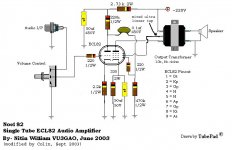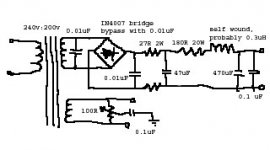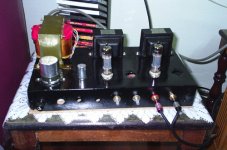choke in, choke out, choke in, then the choke remained.
More liquid and better spacing.
Siemens MKV & Jensen caps arriving in two weeks. By now im happy enough not to be bothered about them.
More liquid and better spacing.
Siemens MKV & Jensen caps arriving in two weeks. By now im happy enough not to be bothered about them.
Triode connection
Skyraider,
Leave the choke,use some oil caps for PSU and make it triode connected!You will never go back if you like that liquid soprano voices!And of course: Let the coupling caps be Jupiter Beeswax.They are for my taste little bit better than Jensens!
Regards,
Yugovitz
skyraider said:Yesterday I have it moded to ultra-linear mode.
The sound: heaven


😀 😀 😀 😀 😀
Previously SE pentode is a bit thick-sounding, female vocals doesnt sound right. Now its brought to a correct balance, and playing complex jazz parts is not a problem. Treble is now smoother, the grains are almost all gone.
If its not for the lack of bass, I would have thrown away my gainclone.


Im gonne try triode mode after this.
Skyraider,
Leave the choke,use some oil caps for PSU and make it triode connected!You will never go back if you like that liquid soprano voices!And of course: Let the coupling caps be Jupiter Beeswax.They are for my taste little bit better than Jensens!
Regards,
Yugovitz
PSU!
Skyraider,
try if you have opportunity (for the best sound) to change the rectifier with a valve one ex. 5U4G or GZ34 (I personally prefer directly heated rcf.),or maybe use some fast diodes but SOFT recovery.They will make sound closer to the valve rectifier.Anyway cheap 1N4007 will be my last choice.And use fast/soft diodes without any snubber!
Regards,
Yugovitz
skyraider said:the power supply is the most critical part.
The tube i'm using is matsushita, and I couldnt find the datasheet for it. I found out that with higher B+, the sound is more alive. The rest is adjusted by ear. Here is the chicken scribble version
Skyraider,
try if you have opportunity (for the best sound) to change the rectifier with a valve one ex. 5U4G or GZ34 (I personally prefer directly heated rcf.),or maybe use some fast diodes but SOFT recovery.They will make sound closer to the valve rectifier.Anyway cheap 1N4007 will be my last choice.And use fast/soft diodes without any snubber!
Regards,
Yugovitz
But I heard that fast diodes has higher switching noise? Any value you recommend?or maybe use some fast diodes but SOFT recovery.
snubber means bypass with small value caps right?without any snubber!
thanks yugo
Snubber!
skyraider said:
But I heard that fast diodes has higher switching noise? Any value you recommend?
Skyraider,
My experience is based only on listening tests on my amps and preamps I build myself and also gained through exchanging ideas and experience of other diy-iers and ofcourse including this great forum and many threads I've read.You can use even better( some claim) shootky diodes (UF 4007 ex.) .For fast/soft use Philips's BYV96E.They are not expensive you can try both .YMMV.
snubber means bypass with small value caps right?
Yes,bypassing each diode with caps.But it is not so simple to put only let's say 0.01 or 0.1 ceramic cap and say I've done.You can calculate some components of the PSU first and then make the snubber values.You even have to put cap with res. in series and in parralel in that connection put another resistor!But according to the more experienced members of this forum for shootkys and for fast/soft diodes it is better not to put anything in parralel with them!
Hope this will help you more:
http://www.hagtech.com/pdf/snubber.pdf
thanks yugo
skyraider, on your heaters you have a 0.1uF in series to ground. This is connected to the 100R 'humdinger' on the front end between each of the filament runs. Assuming 50R-50R split resistance on each side, the F cutoff there is 31kHz. What's the point of that 0.1uF?
It was probably an attempt to reduce supply noise which has been capacitively coupled to the heater winding. I'm not sure it will help. However, it perhaps hides a more serious error: no DC reference for the heaters. There should always be a DC path from heater to cathode, with a resistance of no more than 10's of K. Some exceptions, but that is the general rule. Some datasheets mention this, many don't but put it in the general advice at the start of the data book.
- Status
- Not open for further replies.
- Home
- Amplifiers
- Tubes / Valves
- beginner's ecl82


